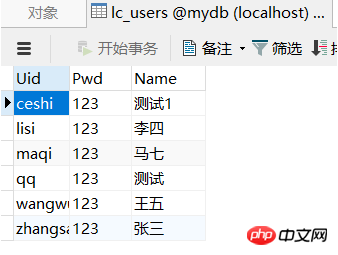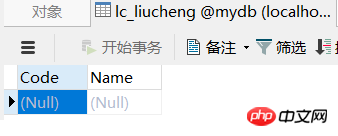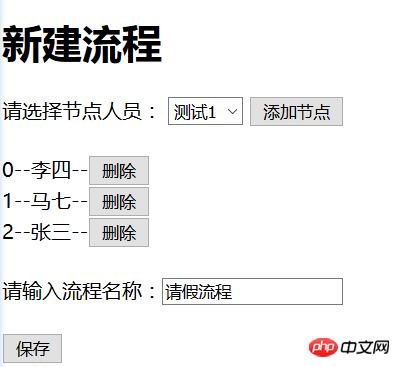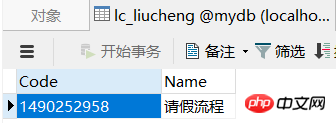Case study of PHP process management function implementation
Core logic: Process management plays a very important role in various systems. You can put the set process into the system and specify several nodes. As long as all nodes pass, it can pass.
Create four database tables:




<!DOCTYPE html>
<html>
<head>
<meta charset="UTF-8">
<title></title>
<script src="bootstrap/js/jquery-1.11.2.min.js"></script>
</head>
<body>
<h2>管理员新建流程</h2>
<p><select id="users" name="users">
<? "./DBDA.class.php" = = "select * from users" = ->query(,0( "<option value='{[0]}'>{[2]}</option>"?>
</select>
<input type="button" value="添加" id="add" />
</p>
<br />
<p>
<?((["jd" "还未添加节点人员!" = ["jd"];
( =>){
= "select name from users where uid='{}'" = ->StrQuery(,0);
"<p>{}--{}--<input type='button' value='删除' class='del' code='{}' /></p>"?>
</p>
<br />
<p><input type="text" id="name" />
</p>
<br />
<input type="button" value="新建" id="addbtn" />
</body>
<script>
"#add").click( uid = $("#users")..:"flowchuli.php",:"POST",:{uid:uid,type:0},:"TEXT",:.location.href = "flow.php"".del").click( k = $(this).attr("code");
$.:"flowchuli.php",:"POST",:{k:k,type:1},:"TEXT",:.location.href = "flow.php"
$("#addbtn").click( name = $("#name")..:"flowchuli.php",:"POST",:{name:name,type:2},:"TEXT",:"添加成功!"</script>
</html><?phpsession_start();require_once "./DBDA.class.php";$db = new DBDA();$type = $_POST["type"];switch($type){ case 0: $uid = $_POST["uid"]; if(empty($_SESSION["jd"])){//暂存节点
$arr = array($uid);//新造数组
$_SESSION["jd"] = $arr;//存入session
}else{ $arr = $_SESSION["jd"];//取数组
$arr[] = $uid;//追加变量到数组
$_SESSION["jd"] = $arr;
} break; case 1: $k = $_POST["k"]; $arr = $_SESSION["jd"]; unset($arr[$k]); $arr = array_values($arr);//重新对数组进行排序,有返回值接收
$_SESSION["jd"] = $arr; break; case 2:
$name = $_POST["name"]; $code = time();//自动生成
$sql = "insert into flow values('{$code}','{$name}')";//流程表
$db->query($sql); //流程节点表
$arr = $_SESSION["jd"]; foreach($arr as $k=>$v){ $sql = "insert into flowpath values(0,'{$code}','{$v}',{$k})"; $db->query($sql);
}
break;
}



3.
Now we are making a login user page flowlogin.php, Submit all steps of the leave application process:
<!DOCTYPE html>
<html>
<head>
<meta charset="UTF-8">
<title></title>
<script src="bootstrap/js/jquery-1.11.2.min.js"></script>
<script src="bootstrap/js/bootstrap.min.js"></script>
<link href="bootstrap/css/bootstrap.min.css" rel="stylesheet" type="text/css"/>
</head>
<style>
.-left:-top:.-left:-top: -.name,.-width:.-top:</style>
<body>
<form ="form-horizontal" role="form">
<h3 ="title">用户登录</h3>
<p ="quanju">
<p ="form-group yangshi1">
<label ="firstname" ="col-sm-2 control-label">用户名:</label>
<p ="col-sm-10">
<input type="text" ="form-control name" id="uid" placeholder="请输入用户名">
</p>
</p>
<p ="form-group yangshi2">
<label ="lastname" ="col-sm-2 control-label">密码:</label>
<p ="col-sm-10">
<input type="text" ="form-control pwd" id="pwd" placeholder="请输入密码">
</p>
</p>
<p ="form-group">
<p ="col-sm-offset-2 col-sm-10">
<p ="checkbox">
<label>
<input type="checkbox"></label>
<label>
<input type="checkbox"></label>
</p>
</p>
</p>
<p ="form-group">
<p ="col-sm-offset-2 col-sm-10">
<button type="button" id="login" ="btn btn-warning" value="登录" ></button>
</p>
</p>
</p>
</form>
</body>
<script>
"#login").click( uid = $("#uid"). pwd = $("#pwd")..:"post",:"flowloginchuli.php",:{uid:uid,pwd:pwd},:"TEXT",:(data.()=="OK".location.href="flowmain.php""用户名或密码有误!"</script>
</html>4. The main page that jumps after logging in flowmain.php
<!DOCTYPE html> <html> <head> <meta charset="UTF-8"> <title></title> </head> <body> <h2>主页面</h2> <a href="flowfq.php">发起流程</a> <a href="flowsh.php">审核流程</a> </body> </html>
5. Initiate the process page flow.php
<!DOCTYPE html>
<html>
<head>
<meta charset="UTF-8">
<title></title>
<script src="bootstrap/js/jquery-1.11.2.min.js"></script>
</head>
<body>
<h2>发起流程</h2>
<form action="flowfqchuli.php" method="post">
请选择流程: <select name="flow">
<?php require_once "./DBDA.class.php"; $db = new DBDA(); $sql = "select * from flow"; $arr = $db->query($sql,0); foreach($arr as $v){ echo "<option value='{$v[0]}'>{$v[1]}</option>";
} ?>
</select>
<br />
<br />
请输入内容: <textarea name="content"></textarea>
<br />
<br />
<input type="submit" value="确定" />
</form>
</body>
</html>6. The processing page for initiating the process flowfq.php
<?phpsession_start();require_once "./DBDA.class.php";$db = new DBDA();
$code = $_POST["flow"];
$uid = $_SESSION["uid"];$content = $_POST["content"];
$time = date("Y-m-d H:i:s");
$sql = "insert into userflow values(0,'{$code}','{$uid}','{$content}',0,'{$time}',0)";$db->query($sql);header("location:flowmain.php");7. The review page flowsh.php
<!DOCTYPE html>
<html>
<head>
<meta charset="UTF-8">
<title></title>
<script src="bootstrap/js/jquery-1.11.2.min.js"></script>
<script src="bootstrap/js/bootstrap.min.js"></script>
<link href="bootstrap/css/bootstrap.min.css" rel="stylesheet" type="text/css"/>
</head>
<body>
<p><h2>审核页面</h2>
<table class="table table-bordered">
<thead>
<tr>
<th>流程代号</th>
<th>发起人</th>
<th>发起内容</th>
<th>通过状态</th>
<th>发起时间</th>
<th>操作</th>
</tr>
</thead>
<tbody>
<?php session_start(); $uid = $_SESSION["uid"]; require_once "./DBDA.class.php"; $db = new DBDA(); //相关子查询(用到父查询的数据)(父查询卡在某一位置)
$sql = "select * from userflow a where towhere>=(select b.order from flowpath b where b.code=a.code and b.uid='{$uid}')";
$arr = $db->query($sql,0);
foreach($arr as $v){ //$v[6];//流程走到的位置towhere
//$v[1];//利用代号和session中存的name查询order
$sql = "select order from flowpath where code='{$v[1]}' and uid='{$uid}'"; $order = $db->StrQuery($sql,0);//该人员在流程中的次序
$str = ""; if($v[6]==$order){ //传主键值
$str = "<a href='flowtgchuli.php?ids={$v[0]}'>通过</a>";
}else{ $str = "<span style='color:green'>已通过</span>";
} echo "<tr>
<th>{$v[1]}</th>
<th>{$v[2]}</th>
<th>{$v[3]}</th>
<th>{$v[4]}</th>
<th>{$v[5]}</th>
<th>{$str}</th>
</tr>";
}
?>
</tbody>
</table>
</p>
</body>
</html>8. Process the review page flowshchuli.php
<?php
session_start();
$uid = $_SESSION["uid"];require_once "./DBDA.class.php";
$db = new DBDA();$ids = $_GET["ids"];
$sql = "update userflow set towhere=towhere+1 where ids='{$ids}'";
$db->query($sql);//判断;流程是否结束(使用相关子查询)
$swc = "update userflow a set isok=1 where ids='{$ids}' towhere>=(select count(*) from flowpath b where b.code=a.code)";header("location:flowsh.php");The process effect is as shown in the figure:
 李思's page:
李思's page:
 After clicking and passing:
After clicking and passing:
 Database: end the process after towhere becomes 1
Database: end the process after towhere becomes 1

Then it’s Ma Qi:
 Then it’s Zhang San:
Then it’s Zhang San:
 Database: ends after isok becomes 1 process
Database: ends after isok becomes 1 process

The above is the detailed content of Case study of PHP process management function implementation. For more information, please follow other related articles on the PHP Chinese website!

Hot AI Tools

Undresser.AI Undress
AI-powered app for creating realistic nude photos

AI Clothes Remover
Online AI tool for removing clothes from photos.

Undress AI Tool
Undress images for free

Clothoff.io
AI clothes remover

Video Face Swap
Swap faces in any video effortlessly with our completely free AI face swap tool!

Hot Article

Hot Tools

Notepad++7.3.1
Easy-to-use and free code editor

SublimeText3 Chinese version
Chinese version, very easy to use

Zend Studio 13.0.1
Powerful PHP integrated development environment

Dreamweaver CS6
Visual web development tools

SublimeText3 Mac version
God-level code editing software (SublimeText3)

Hot Topics
 1387
1387
 52
52
 PHP 8.4 Installation and Upgrade guide for Ubuntu and Debian
Dec 24, 2024 pm 04:42 PM
PHP 8.4 Installation and Upgrade guide for Ubuntu and Debian
Dec 24, 2024 pm 04:42 PM
PHP 8.4 brings several new features, security improvements, and performance improvements with healthy amounts of feature deprecations and removals. This guide explains how to install PHP 8.4 or upgrade to PHP 8.4 on Ubuntu, Debian, or their derivati
 7 PHP Functions I Regret I Didn't Know Before
Nov 13, 2024 am 09:42 AM
7 PHP Functions I Regret I Didn't Know Before
Nov 13, 2024 am 09:42 AM
If you are an experienced PHP developer, you might have the feeling that you’ve been there and done that already.You have developed a significant number of applications, debugged millions of lines of code, and tweaked a bunch of scripts to achieve op
 How To Set Up Visual Studio Code (VS Code) for PHP Development
Dec 20, 2024 am 11:31 AM
How To Set Up Visual Studio Code (VS Code) for PHP Development
Dec 20, 2024 am 11:31 AM
Visual Studio Code, also known as VS Code, is a free source code editor — or integrated development environment (IDE) — available for all major operating systems. With a large collection of extensions for many programming languages, VS Code can be c
 Explain JSON Web Tokens (JWT) and their use case in PHP APIs.
Apr 05, 2025 am 12:04 AM
Explain JSON Web Tokens (JWT) and their use case in PHP APIs.
Apr 05, 2025 am 12:04 AM
JWT is an open standard based on JSON, used to securely transmit information between parties, mainly for identity authentication and information exchange. 1. JWT consists of three parts: Header, Payload and Signature. 2. The working principle of JWT includes three steps: generating JWT, verifying JWT and parsing Payload. 3. When using JWT for authentication in PHP, JWT can be generated and verified, and user role and permission information can be included in advanced usage. 4. Common errors include signature verification failure, token expiration, and payload oversized. Debugging skills include using debugging tools and logging. 5. Performance optimization and best practices include using appropriate signature algorithms, setting validity periods reasonably,
 How do you parse and process HTML/XML in PHP?
Feb 07, 2025 am 11:57 AM
How do you parse and process HTML/XML in PHP?
Feb 07, 2025 am 11:57 AM
This tutorial demonstrates how to efficiently process XML documents using PHP. XML (eXtensible Markup Language) is a versatile text-based markup language designed for both human readability and machine parsing. It's commonly used for data storage an
 PHP Program to Count Vowels in a String
Feb 07, 2025 pm 12:12 PM
PHP Program to Count Vowels in a String
Feb 07, 2025 pm 12:12 PM
A string is a sequence of characters, including letters, numbers, and symbols. This tutorial will learn how to calculate the number of vowels in a given string in PHP using different methods. The vowels in English are a, e, i, o, u, and they can be uppercase or lowercase. What is a vowel? Vowels are alphabetic characters that represent a specific pronunciation. There are five vowels in English, including uppercase and lowercase: a, e, i, o, u Example 1 Input: String = "Tutorialspoint" Output: 6 explain The vowels in the string "Tutorialspoint" are u, o, i, a, o, i. There are 6 yuan in total
 Explain late static binding in PHP (static::).
Apr 03, 2025 am 12:04 AM
Explain late static binding in PHP (static::).
Apr 03, 2025 am 12:04 AM
Static binding (static::) implements late static binding (LSB) in PHP, allowing calling classes to be referenced in static contexts rather than defining classes. 1) The parsing process is performed at runtime, 2) Look up the call class in the inheritance relationship, 3) It may bring performance overhead.
 What are PHP magic methods (__construct, __destruct, __call, __get, __set, etc.) and provide use cases?
Apr 03, 2025 am 12:03 AM
What are PHP magic methods (__construct, __destruct, __call, __get, __set, etc.) and provide use cases?
Apr 03, 2025 am 12:03 AM
What are the magic methods of PHP? PHP's magic methods include: 1.\_\_construct, used to initialize objects; 2.\_\_destruct, used to clean up resources; 3.\_\_call, handle non-existent method calls; 4.\_\_get, implement dynamic attribute access; 5.\_\_set, implement dynamic attribute settings. These methods are automatically called in certain situations, improving code flexibility and efficiency.




